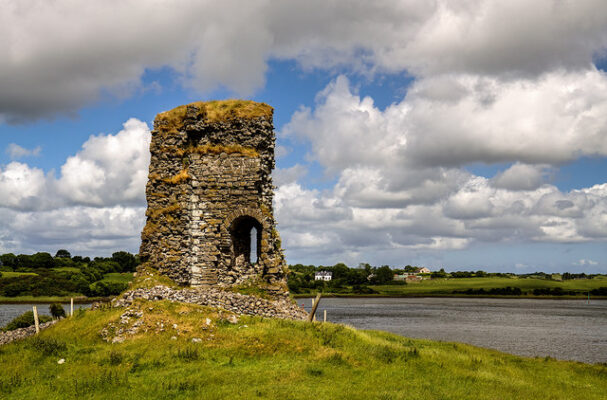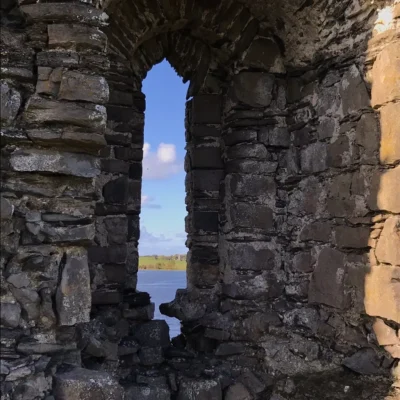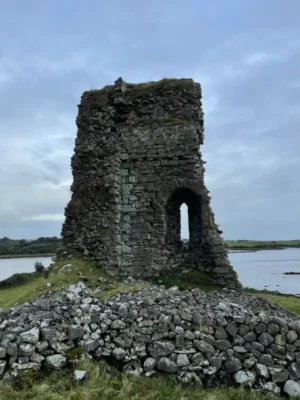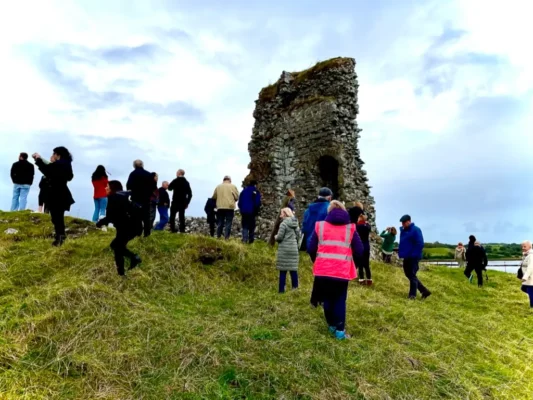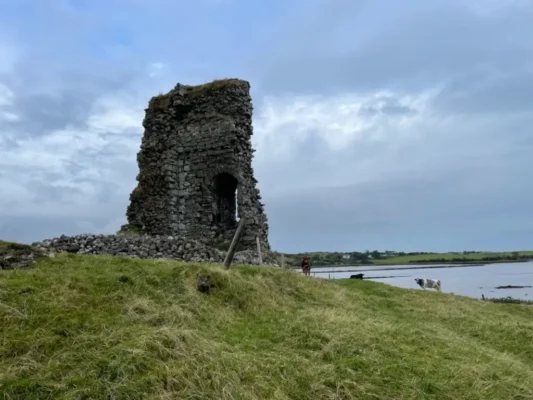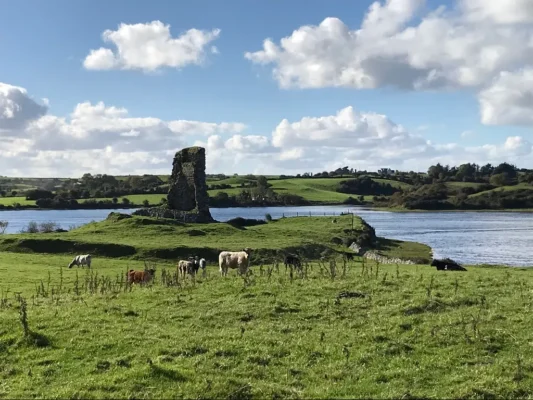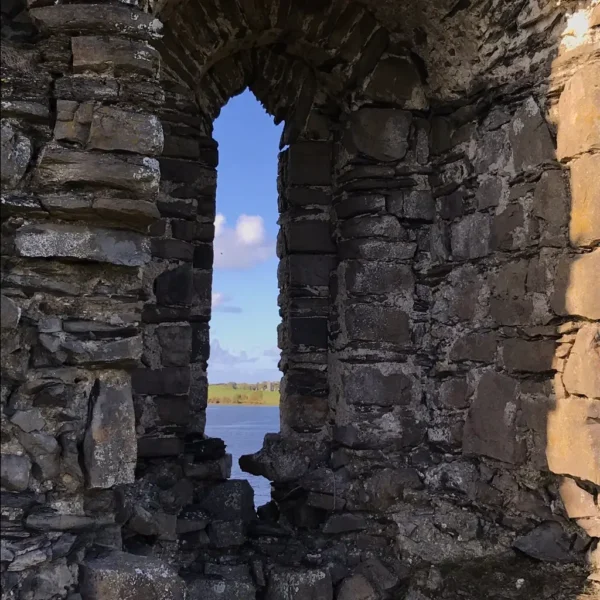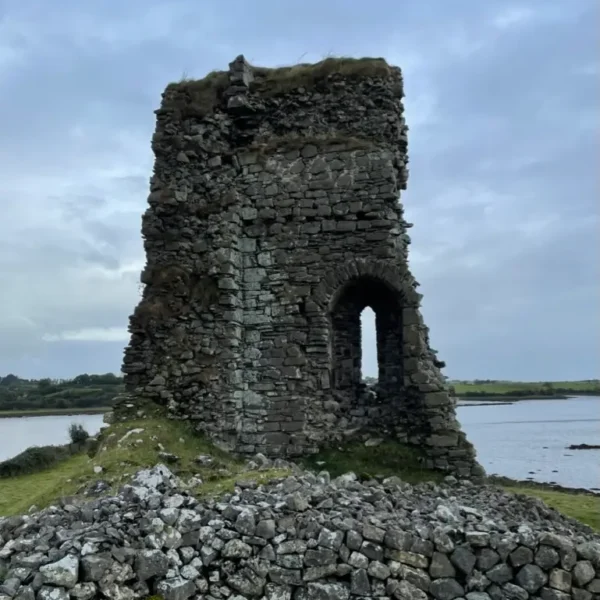Castleconnor
January 21, 2025 2025-07-10 1:38Castleconnor
Castleconnor Castle
A Timeless Sentinel of O’Dubhda History
Perched strategically on a promontory jutting into the River Moy in Killala Bay, Castleconnor Castle stands as a powerful testament to the enduring legacy of the Ó Dubhda clan in County Sligo. This formidable ruin invites you to explore centuries of Irish history, revealing its unique architectural features and the captivating stories woven into its very stones.
I. Overview: Journey Through Time at Castleconnor
Castleconnor Castle, located in County Sligo, is a significant O’Dubhda stronghold with a history deeply intertwined with the clan’s power and influence in the medieval and post-medieval periods. Situated at a crucial point on the River Moy, its strategic importance in controlling the waterways and surrounding lands made it a focal point of clan activities and regional conflicts. This introduction sets the stage for an exploration into its construction, its role in the shifting political landscape of the time, and its lasting significance to our clan’s heritage.
II. The Storied Past: Castleconnor Through the Ages
A. Early Construction and Clan Dominance
The history of Castleconnor Castle is firmly rooted in the ascendancy of the Ó Dubhda clan. The castle, a smaller keep, was built around 1520 A.D. by Conor O’Dowd, who was the chieftain of Tireragh in west Sligo. This construction marked a period of renewed O’Dubhda strength and territorial assertion, as they sought to solidify their control over their ancestral lands and strategic waterways.
B. A Pivotal Site in Turbulent Times
Throughout the 16th century, Castleconnor remained a vital stronghold for the Ó Dubhda clan amidst increasing pressures from English expansion and shifting alliances among Gaelic lordships. It bore witness to many significant events and disputes. Notably, in 1580, Tadhg Riabhach O’Dowda, a prominent chief of the clan, met his end at Castleconnor, reportedly killed in a fall from the roof. Around the same period, another chief, Daithí O’Dubhda, was also recorded as being murdered at Castleconnor, with some accounts suggesting this occurred in 1594 by a ‘soldier of the Queen’. These events underscore the dangerous and volatile nature of the times and the constant struggle for power and survival.
C. Transition and Legacy
As the centuries progressed and the Gaelic order declined, Castleconnor, like many other traditional strongholds, gradually fell into ruin. Its strategic importance diminished, and it transitioned from a vibrant center of power to a silent monument to a bygone era. Today, its remnants stand as a powerful reminder of the Ó Dubhda clan’s resilience and their deep connection to the land of Sligo.
III. Architectural Marvels: Unveiling Castleconnor’s Design
A. The Strategic Keep
Though time and elements have taken their toll, the surviving remains of Castleconnor Castle offer glimpses into its construction and defensive capabilities, reflecting the typical design of a smaller keep or tower house of its period. Castleconnor was designed as a keep, a sturdy, multi-storied defensive tower. Its strategic location on a promontory into the River Moy was paramount, providing natural defenses on multiple sides and control over water routes. The thickness of its remaining stone walls speaks to the robust engineering intended to withstand sieges and provide a secure residence for the O’Dubhda chieftain and his retinue.
B. Construction Materials and Techniques
The castle was constructed primarily from local stone, expertly dressed and laid by skilled masons. This solid masonry ensured its durability against both the elements and external threats. The design likely incorporated features common to Irish tower houses, such as internal stairways, defensive battlements, and possibly various living quarters and storage areas within its compact footprint.
IV. Legends and Lore: Tales from Castleconnor’s Shadows
A. The Fate of Tadhg Riabhach O’Dowda
The walls of Castleconnor hold whispers of dramatic events, none more poignant than the fate of Tadhg Riabhach O’Dowda. His death in 1580, attributed to a fall from the castle roof, is a stark reminder of the perils faced by clan chiefs in a turbulent era. Whether an accident, a tragic misstep, or a more sinister deed, this event remains etched in the historical memory associated with the castle.
B. Echoes of Leadership and Conflict
Beyond specific tragic incidents, the castle embodies countless stories of the Ó Dubhda’s daily life, their strategic councils, and their efforts to protect their territory. It stood as a symbol of their authority and resilience, a silent witness to generations of clan activities, alliances forged, and conflicts endured against encroaching powers.
V. Visiting Castleconnor Today: A Glimpse into the Past
A. Location & Access
Location: Castleconnor Castle is situated on a promontory extending into the River Moy in Killala Bay, near Ballina, County Sligo, Ireland.
Accessibility: As a historic ruin, the castle is generally accessible, though it is recommended to be mindful of local conditions. It often involves walking on uneven terrain.
Opening Hours: Accessible year-round during daylight hours.
Admission: Free of charge.
B. What to Expect
Visitors to Castleconnor Castle will find the evocative remains of the O’Dubhda’s keep. While parts of it have succumbed to time, its prominent position offers a tangible link to its past importance. You can expect a serene yet powerful atmosphere, allowing for quiet contemplation of the history that unfolded within and around its walls. The views over the River Moy and Killala Bay are also a highlight.
C. Important Considerations
Wear sturdy footwear, as the ground around ruins can be uneven and potentially overgrown.
Respect the historical nature of the site and any local signage.
Be aware that facilities are limited or non-existent at the site, given its nature as a ruin.
Check local weather conditions before visiting, as exposure to the elements can be significant due to its coastal position.
Castleconor Castle
Caisleán Chonchúir (Castle of Conor)
54°09'41.5"N, 9°08'08.6"W
Parish of Castleconor, Barony of Tireragh
Near Ballina, County Sligo, Ireland
Tower house
Described as a "smaller keep" within the O'Dowd fortification network
c. 1520 A.D. (Conor O'Dowd)
Built on site of possible 13th-century fortification
1689-1691 (Williamite Wars)
Used as Williamite military base before abandonment
Visible ruins documented in 1837
In a cow's field
Requires permission from owner
Possible with boots and a little grit to access from the road
Built by Conor O'Dowd, Taoiseach (chief) of the O'Dubhda clan
Part of ~20 castle defensive network protecting O'Dowd territory
Strategic position controlling River Moy and Ballina-Sligo route
Symbol of Gaelic power until Williamite conquest
One of the last Gaelic tower houses built before English conquest, representing the twilight of traditional Irish castle building and centuries of O'Dowd territorial control
